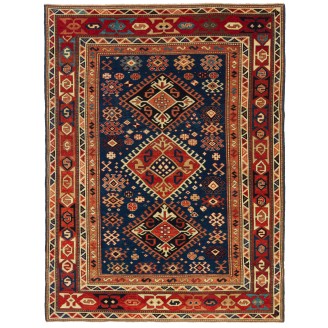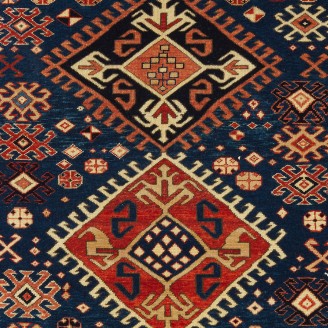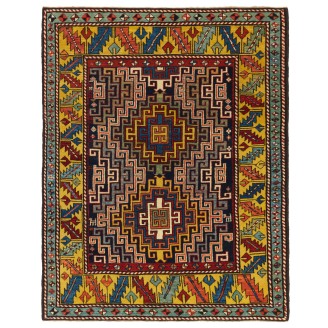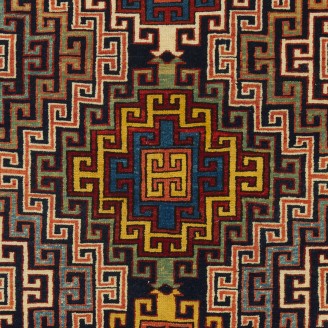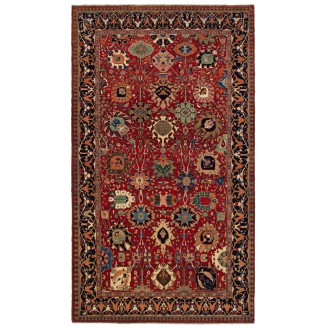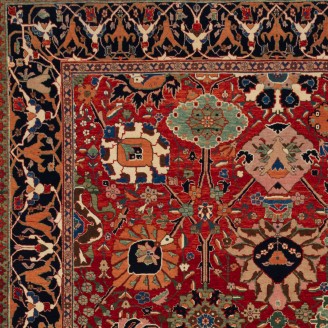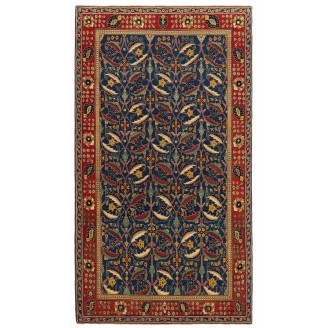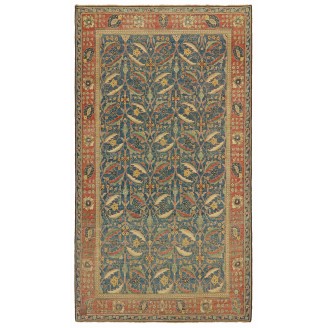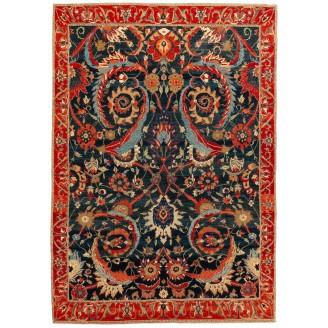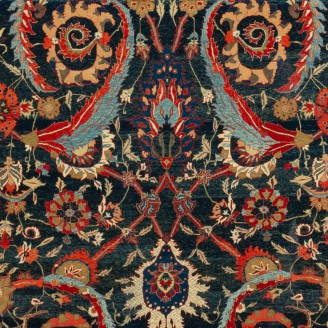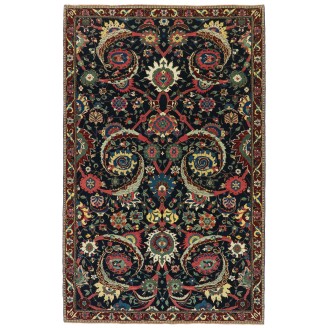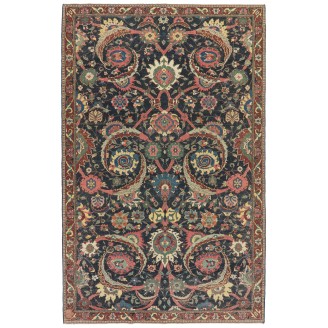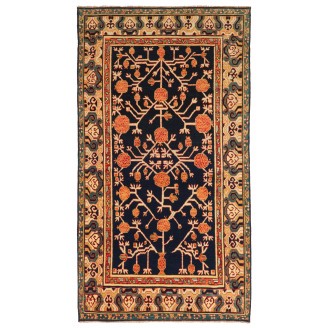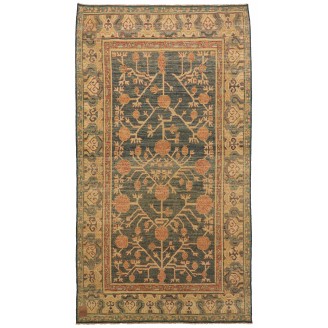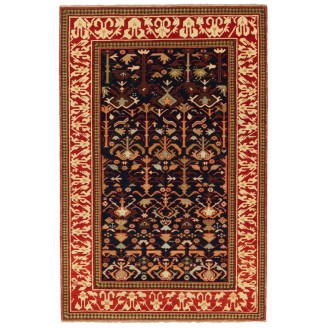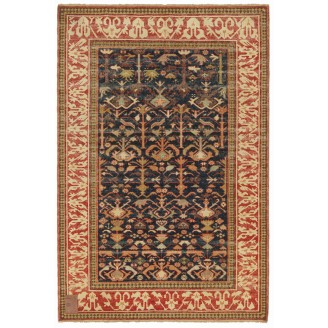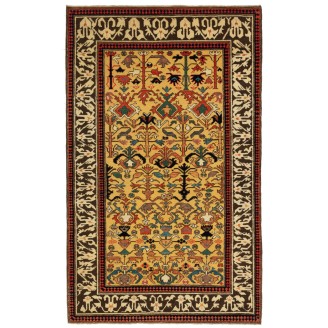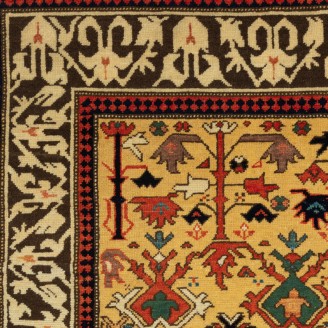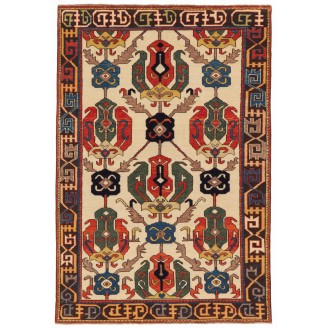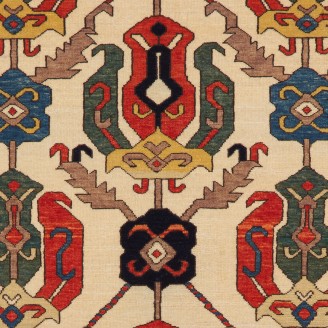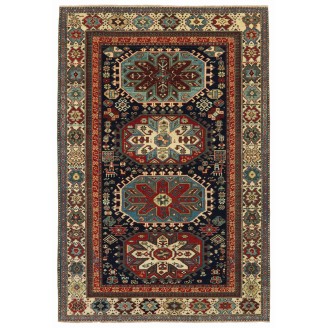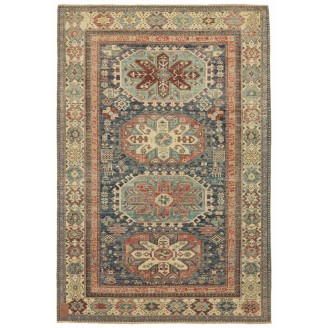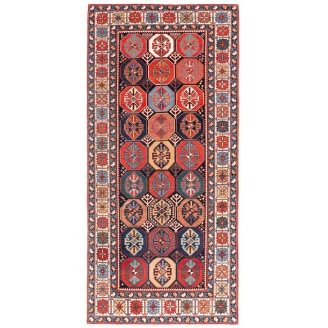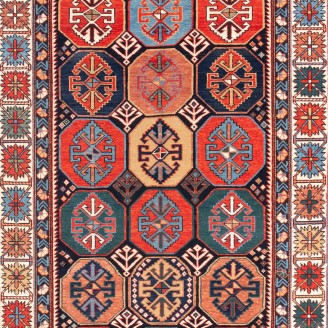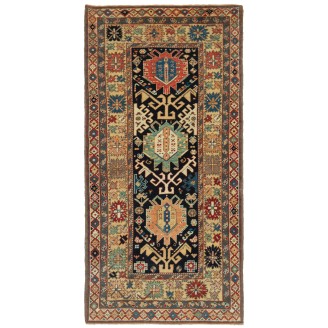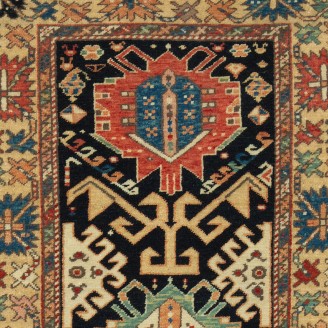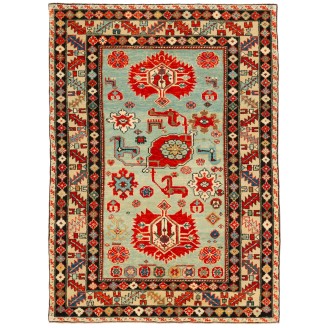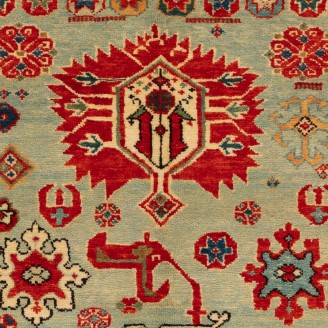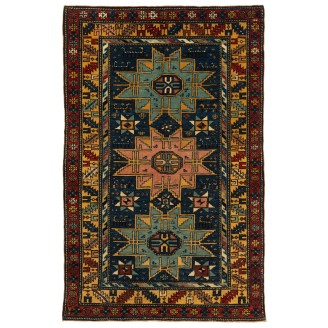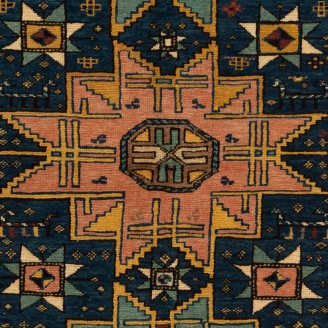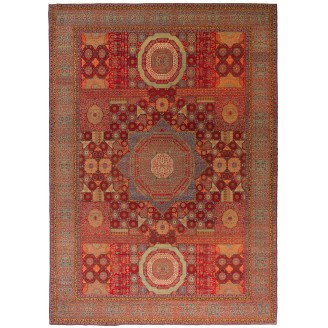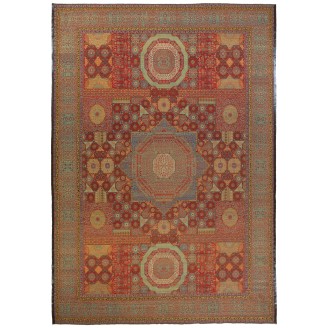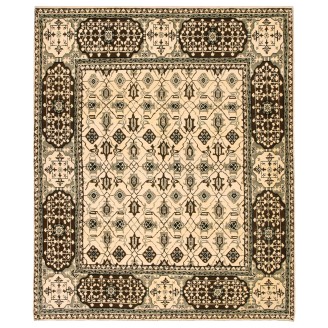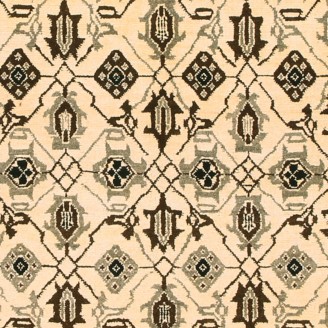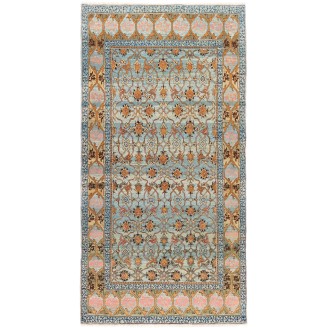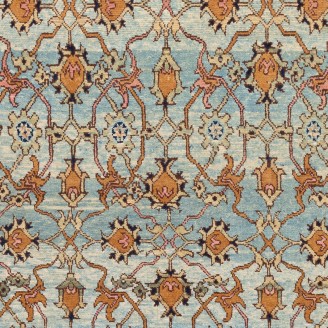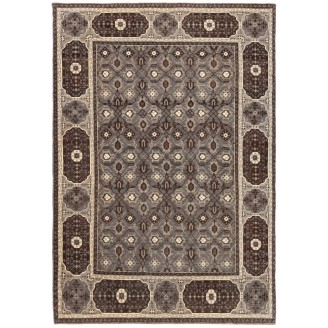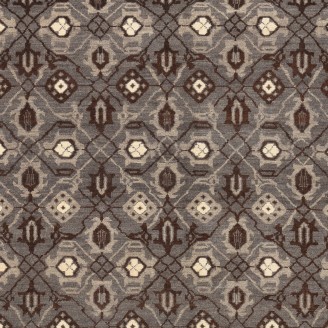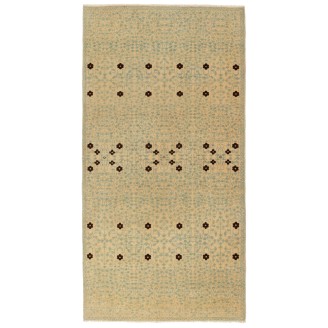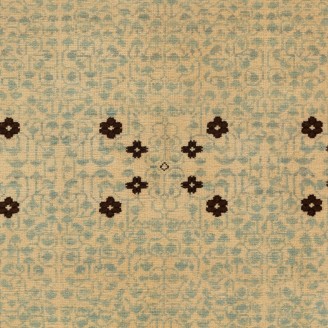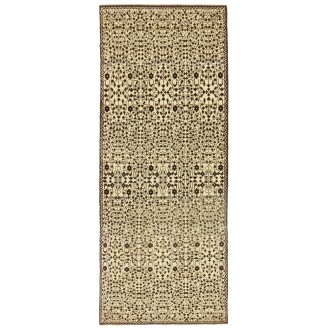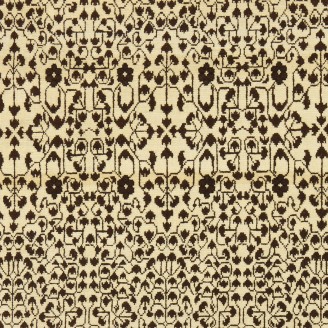Model: ART00440
Dimensions: 5'4" X 7'1"(165cm x 216cm)
This is a complete hooked field with double medallions rug from the late 19th century, Kazak region, Caucasus area. A striking field design features three medallions each with concentric hook motifs, with S patterns in the center of the medallions. It is framed with a series of borders. Vivid colors..
Price:
$5,700
Ex Tax:$5,700
Model: ART00428
Dimensions: 4'3" X 5'4"(130cm x 163cm)
This is a complete hooked field with double medallions rug from the late 19th century, Kazak region, Caucasus area. A striking field design features two medallions each with concentric hook motifs, with a double latch-hooks design in the center of medallions. It is framed with a series of borders, t..
Price:
$2,500
Ex Tax:$2,500
Model: ART00530
Dimensions: 6'7" X 11'6"(202cm x 351cm)
The source of the carpet comes from the book by Dimand, Maurice S., and Jean Mailey. Oriental Rugs in the Metropolitan Museum of Art. New York: The Metropolitan Museum of Art, 1973. no. 38, p. 110, ill. This is a vase technique with rows of flowers carpet designed in the 17th century from the Kerman..
Price:
$28,300
Ex Tax:$28,300
Model: ART00676
Dimensions: 9'1" X 5'1"(279cm x 156cm)
Kerman Vase-Technique Carpet (Model: ART00676) – A Tribute to 17th Century Persian WeavingThe Kerman Vase-Technique Carpet (Model: ART00676) by Ararat Rugs is a distinguished creation inspired by the renowned 17th-century Kerman "Vase" carpets of southeastern Persia. This piece embodies the elegance..
Price:
$18,600
Ex Tax:$18,600
Model: ART00242
Dimensions: 8'5" X 11'10"(258cm x 363cm)
The source of carpet comes from the book Museo Calouste Gulbenkian, Printed by Gulbenkian Museum Lisbon, in 2015, nr.52. This is a vase-technique carpet design in the 17th century in the Kerman region, of Persia. In the 16th century, in Safavid Persia, medallion rugs were among the most appreciated,..
Price:
$33,000
Ex Tax:$33,000
Model: ART00737
Dimensions: 6'7" X 10'4"(201cm x 317cm)
Introducing the exquisite Kerman Vase-Technique Carpet (Model: ART00737) from Ararat Rugs, a masterful revival of the renowned 16th-century Sickle-Leaf carpets, such as the one housed in the Gulbenkian Museum in Lisbon. This handcrafted piece captures the essence of Safavid-era artist..
Price:
$32,600
Ex Tax:$32,600
Model: ART00622
Dimensions: 4'6" X 8'4"(139cm x 255cm)
Introducing the exquisite Khotan Rug with Pomegranate Design (Model: ART00622) from Ararat Rugs, a masterpiece that embodies the rich cultural tapestry of the ancient Silk Road. Handwoven in the historic oasis city of Khotan, located in present-day Xinjiang, China, this rug seamlessly blen..
Price:
$5,400
Ex Tax:$5,400
Model: ART00717
Dimensions: 5'0" X 3'4"(153cm x 104cm)
The source of the rug comes from the book Orient Star – A Carpet Collection, E. Heinrich Kirchheim, Hali Publications Ltd, 1993 nr.27. This is an ascending palmettes and flowers design rug from the 18th century, Kuba region, Eastern Caucasus area. Kuba rugs of this predominantly yello..
Price:
$3,025
Ex Tax:$3,025
Model: ART00518
Dimensions: 3'6" X 5'8"(108cm x 174cm)
The source of the rug comes from the book Orient Star – A Carpet Collection, E. Heinrich Kirchheim, Hali Publications Ltd, 1993 nr.27. This is an ascending palmettes and flowers design rug from the 18th century, Kuba region, Eastern Caucasus area. Kuba rugs of this predominantly yellow-ground group ..
Price:
$3,350
Ex Tax:$3,350
Model: ART00718
Dimensions: 5'10" X 4'0"(178cm x 122cm)
This is an ascending palmette and flower design Shirvan rug from the 19th century, Kuba region, Eastern Caucasus area. Kuba rugs of this predominantly yellow-ground group are well-known and highly desirable among specialist collectors. A listing of the examples to have appeared at auction ..
Price:
$4,800
Ex Tax:$4,800
Model: ART00729
Dimensions: 6'9" X 4'7"(206cm x 141cm)
The design source of the rug comes from the book Oriental Rugs Volume 1 Caucasian, Ian Bennett, Oriental Textile Press, Aberdeen 1993, nr.306. This is an unusual hooked octagonal medallion design rug from the 19th century, Kuba region, Caucasus area. The series of octagon medallions arranged in hori..
Price:
$5,518
Ex Tax:$5,518
Model: ART00032
Dimensions: 4'0" X 8'5"(123cm x 258cm)
The source of rug comes from the book Tapis du Caucase - Rugs of the Caucasus, Ian Bennett & Aziz Bassoul, The Nicholas Sursock Museum, Beirut, Lebanon 2003, nr.79. This is a very colorful, dramatic, and unusual design rug from the late 19th century, Kuba region, Caucasus area. The series of oct..
Price:
$7,900
Ex Tax:$7,900
Model: ART00489
Dimensions: 3'3" X 6'9"(100cm x 206cm)
The source of the rug comes from the book Oriental Rugs Volume 1 Caucasian, Ian Bennett, Oriental Textile Press, Aberdeen 1993, pg.244. This is a single vertical palmette design rug from the early 19th century, Kuba region, Caucasus area. This is an unusual stylized version of the Caucasian shield-l..
Price:
$2,750
Ex Tax:$2,750
Model: ART00049
Dimensions: 3'4" X 4'9"(102cm x 145cm)
The source of the rug comes from the book Oriental Rugs Volume 1 Caucasian, Ian Bennett, Oriental Textile Press, Aberdeen 1993, pg.247. This is a Harshang design rug with palmettes from the early 19th century, Kuba region, Caucasus area. This is a stylized interpreted version of the Caucasian 'split..
Price:
$2,400
Ex Tax:$2,400
Model: ART00380
Dimensions: 3'2" X 4'11"(99cm x 152cm)
The source of the rug comes from the book Orient Star - A Carpet Collection, E. Heinrich Kirchheim, Hali Publications Ltd, 1993 nr.30 and Oriental Rugs Volume 1 Caucasian, Ian Bennett, Oriental Textile Press, Aberdeen 1993, pg.326. This is a large stellar medallion as "Lesghi stars" rug from the 19t..
Price:
$2,500
Ex Tax:$2,500
Model: ART00733
Dimensions: 13'6" X 19'1"(413cm x 584cm)
Origin and InspirationThe Mamlouk Rug is a contemporary masterpiece that draws its inspiration from the rich textile traditions of the Mamlouk Sultanate, which reigned over Egypt and the Levant from the 13th to the 16th centuries. Renowned for their intricate geometric patterns and harmonious c..
Price:
$82,000
Ex Tax:$82,000
Model: ART00266
Dimensions: 5'0" X 6'1"(154cm x 187cm)
The source of carpet comes from the Mercer Collection Sotheby's 2000 (catalog cover). This Mamluk-Cairene carpet is known, curiously featuring some type of lattice was designed in the early 16th-century rug by Mamluk Sultane of Cairo, Egypt. This piece from the Bavarian National Museum in Munich is ..
Price:
$4,800
Ex Tax:$4,800
Model: ART00270
Dimensions: 4'1" X 7'10"(126cm x 241cm)
The source of the carpet comes from the Mercer Collection Sotheby's 2000 (catalog cover). This Mamluk-Cairene carpet is known, curiously featuring some type of lattice was designed in the early 16th-century rug by Mamluk Sultane of Cairo, Egypt. This piece from the Bavarian National Museum in Munich..
Price:
$5,200
Ex Tax:$5,200
Model: ART00280
Dimensions: 4'11" X 7'1"(151cm x 217cm)
The source of the carpet comes from the Mercer Collection Sotheby's 2000 (catalog cover). This Mamluk-Cairene carpet is known, curiously featuring some type of lattice was designed in the early 16th-century rug by Mamluk Sultane of Cairo, Egypt. This piece from the Bavarian National Museum in Munich..
Price:
$5,600
Ex Tax:$5,600
Model: ART00273
Dimensions: 2'10" X 5'5"(87cm x 167cm)
The source of carpet comes from the book Völker, Angela, Die orientalischen Knüpfteppiche das MAK, Vienna: Böhlau, 2001: 42–5. That rug with the central star was designed in the early 16th-century rug by Mamluk Sultane of Cairo, Egypt. It is exhibited at MAK – Museum of Applied Arts, Vienna Austria...
Price:
$2,500
Ex Tax:$2,500
Model: ART00272
Dimensions: 2'9" X 6'11"(86cm x 211cm)
The source of the rug comes from the book Völker, Angela, Die orientalischen Knüpfteppiche das MAK, Vienna: Böhlau, 2001: 42–5. This rug with the central star was designed in the early 16th-century rug by Mamluk Sultane of Cairo, Egypt. It is exhibited at MAK – Museum of Applied Arts, Vienna Austria..
Price:
$2,150
Ex Tax:$2,150
